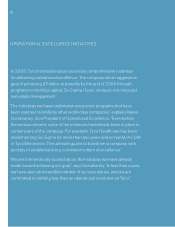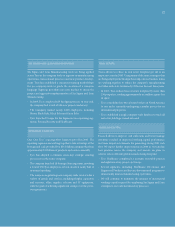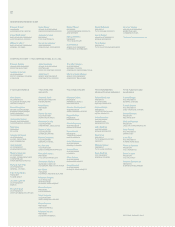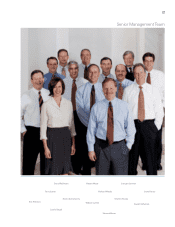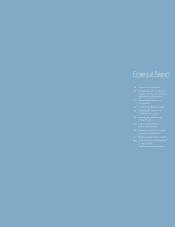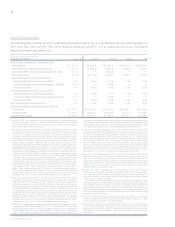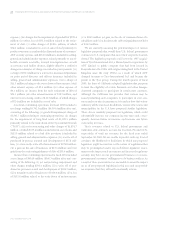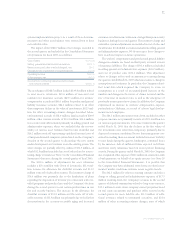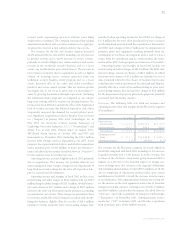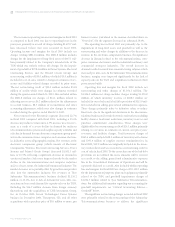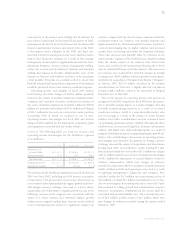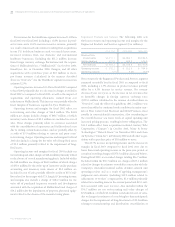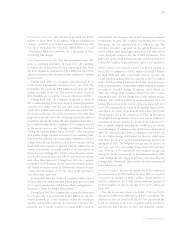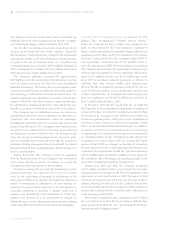ADT 2003 Annual Report Download - page 32
Download and view the complete annual report
Please find page 32 of the 2003 ADT annual report below. You can navigate through the pages in the report by either clicking on the pages listed below, or by using the keyword search tool below to find specific information within the annual report.
30
cost savings represents the rent, plant operating expenses and
depreciation on the assets that will no longer be incurred.
Historically, when we made an acquisition, we began to
integrate the acquired company with our existing operations
immediately. As part of this integration process, we often elim-
inate duplicate functions by closing corporate and administrative
offices, and we attempt to make the combined companies more
cost efficient by combining manufacturing facilities, product
lines, sales offices and marketing efforts. As a result of our
integration processes, most acquired companies are no longer
separately identifiable. Consequently, we are generally unable
to separately track the post-acquisition financial results of
acquired companies. The discussions following the tables
below include percentages for revenue growth or decline that
exclude increased revenue attributable to specified acquisitions
and that eliminate the effects of period to period currency fluc-
tuations. Revenue growth or decline percentages excluding the
specified acquisitions are estimates calculated by assuming the
acquisitions were made at the beginning of the relevant fiscal
periods by adding back pre-acquisition revenue of the specified
acquired companies for both periods in the comparison. A
majority of the companies that we acquire operate within the
same industry as the segment into which the acquired company
is integrated and, consequently, we assume that the companies
that we acquire generally have a comparable growth percentage.
We calculate segment growth using this methodology because
we generally do not have the ability to capture post-acquisition
revenues related to individual acquisitions since most companies
are immediately integrated upon acquisition. The calculations
of the growth analysis, excluding acquisitions discussed in the
segment narratives below, include all acquisitions with a purchase
price of $10 million or more in the calculation and do not include
acquisitions with a purchase price of less than $10 million, due
to the relative size of these smaller acquisitions compared to
Tyco’s operating results and the large number of acquisitions
during certain of the periods presented. These smaller acquisi-
tions represent approximately 6% of the total purchase price
for all acquisitions during the years ended September 30, 2003
and 2002. Since these estimates are based on pre-acquisition
revenues, they are not necessarily indicative of post-acquisition
results. This calculation is similar to the method used in calcu-
lating the acquisition-related pro forma results of operations in
Note 2 to the Consolidated Financial Statements, pursuant to
Statement of Financial Accounting Standards (“SFAS”) No. 141.
In the discussions that follow, we describe the reasons for
changes in results for each segment, although we do not quan-
tify the impact of every factor. In order to quantify each factor
contributing to a change in operating income and margins, we
would need to exclude the results of acquisitions. As previously
noted, since acquisitions are generally integrated within our
existing operations immediately upon acquisition, we generally
do not have the ability to exclude the effect of acquired busi-
nesses when quantifying increases and decreases in operating
income and margins.
CHANGES IN ESTIMATES
Changes in Estimates Recorded During the Quarter Ended March 31,
2003 The preparation of consolidated financial statements in
conformity with GAAP requires management to make extensive
use of estimates and assumptions that affect the reported
amount of assets and liabilities and disclosure of contingent
assets and liabilities and the reported amounts of revenues and
expenses. Significant estimates in the Company’s Consolidated
Financial Statements include restructuring and other charges
and credits, purchase accounting liabilities, allowances for
doubtful accounts receivable, estimates of future cash flows
associated with asset impairments, useful lives for depreciation
and amortization, loss contingencies, net realizable value of
inventories, fair values of financial instruments, estimated con-
tract revenues and related costs, environmental liabilities,
income taxes and tax valuation reserves, and the determination
of discount and other rate assumptions for pension and post-
retirement employee benefit expenses. Actual results could
differ from these estimates. Changes in estimates are recorded
in the results of operations in the period that the events and
circumstances giving rise to such changes occur.
During the quarter ended March 31, 2003, the Company
intensified a process whereby internal audits and detailed con-
trols and operating reviews were conducted. As a result of this
process, the Company recorded $388.7 million of pre-tax
charges relating to new information and changes in facts and
circumstances occurring during the quarter. The process
included assessing the continued recoverability of assets,
including accounts receivable, inventory and installed security
systems and equity investments, and the estimated costs of
settling legal, environmental and insurance obligations. The
assessments were based on an analysis of the impact of circum-
stances that occurred during the quarter and on our assessment
of the recoverability of certain assets and costs to settle certain
liabilities. The assessments include changes in judgments relative
to the adequacy of reserves and contingent liabilities. Con-
current with this review process and resulting assessments by
management during the quarter, we decided to discontinue
existing product lines and terminate an information technology
TYCO INTERNATIONAL LTD.
Management’s Discussion and Analysis of Financial Condition and Results of Operations


